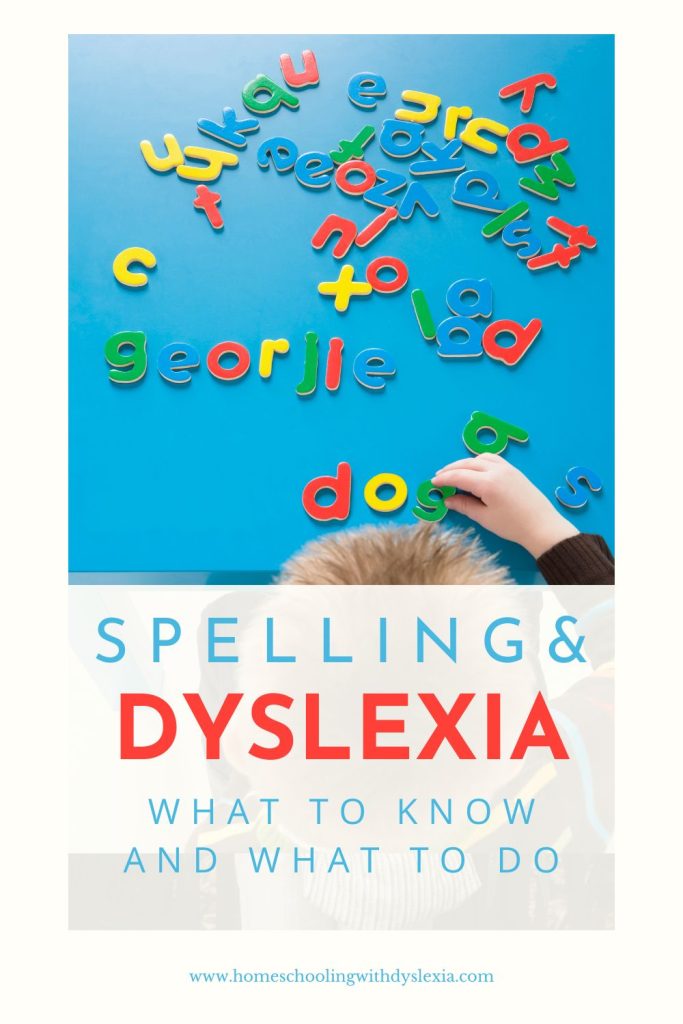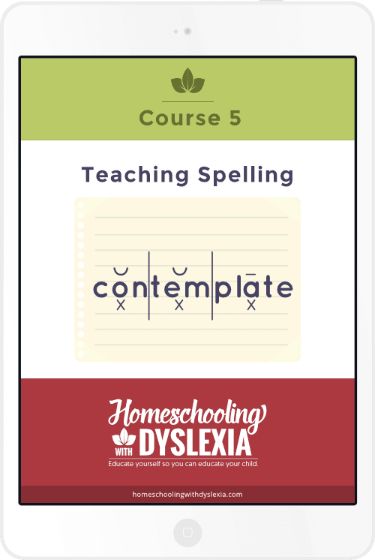I got an email last week asking about spelling with an older student with dyslexia. I get asked this question fairly frequently so I thought I’d write a blog post on it.
If you prefer to listen to this post, click on the player below:
Spelling and Dyslexia: Spelling Development
For kids with dyslexia who have language-based learning difficulties, mastering language-based activities is a struggle and building fluency in these areas takes more time and different methods than for traditional learners. This means that learning to read is difficult and slow to develop. It is also true that spelling is even more difficult and even slower to develop. This is not to say that spelling won’t ever develop, but your expectation should be that it will be difficult and delayed; more difficult and delayed even than learning to read.
What you may be seeing is that your child can understand and complete their spelling lessons, but often forget the rule when they are actually writing. Often, kids with dyslexia will resort to very phonetic spelling. So for example, ‘kat’ for cat, ‘fon’ for phone, ‘wuz’ for was, etc.
Spelling Remediation and Accommodation
As with many areas of teaching kids with dyslexia, the best approach to teaching spelling is by using a combination of remediation and accommodation.
Remediation is the remedying or the fixing of the areas of weakness. This is accomplished by using some kind of research-based, evidence-based spelling curriculum that systematically teaches the rules of spelling while allowing plenty of opportunity to practice applying the rules into their writing.
Accommodations change the way students access information and demonstrate their knowledge. Basically, they are any tool or strategy that allows students to work at their intellectual ability even though they are not able to read, or write, or spell what they want to say.
Accommodations in spelling are primarily provided by using tools to help the struggling speller to spell better in their everyday writing. This is usually provided in the form of assistive technology which includes phonetic-based spell checkers and speech-to-text technology.
Both of these forms of technology allow students to express their thoughts and their knowledge with words despite their weak spelling abilities.
Spelling in the elementary years
In the younger years, especially the elementary years, using an Orton-Gillingham-based reading and spelling program is an excellent way to provide the kind of remediation that our kids need. Some programs that are especially good for parents to use at home are:
All About Reading and Spelling: Read my Review and Purchase
Logic of English: Read my Review and Purchase
Reading Horizons: Review and Purchase
My first choice for spelling has always been All About Spelling. My primary reason for saying this is that All About Reading separates reading and spelling instruction. As I mentioned previously when I talked about the difference between learning to read and learning to spell, decoding words (reading) is a lot easier than encoding (spelling) them. When reading, it is simpler to know that /ee/ says the long sound of /e/ whereas in spelling the long sound of /e/, we can choose one of many ways to make that sound:
/e/ as in we
/ee/ as in three
/ea/ as in peach
/ie/ as in piece
/ei/ as in ceiling
/e-e/ as in here
/y/ as in happy
Knowing which way to spell a particular sound such as the long sound of /e/, takes time and many exposures therefore kids will learn to read much quicker than they learn to spell.
Holding kids back from progressing with reading until their spelling ability matches their reading ability makes for very slow progress. By separating reading and spelling instruction, students can work at the reading level they need (or not work on reading if your child is already reading) and work on spelling at their level.
Another plus of the All About Reading and Spelling program is that it is super affordable. They have been putting a lot of work into upgrading their materials, adding color to their already well written stories and student activity books.
Teaching Tip: The primary focus in the elementary years is reading. We want to get our kids reading because the more they read, the more they’re exposed to words, and the more they will be exposed to proper spelling.
As I said before, spelling develops slowly and many kids in the elementary years will not spell particularly well. Moving into the middle school and high school years looks a little different. Let’s talk about that next.

Spelling With Dyslexia in the Middle School Years
Most kids in the middle school years will begin to develop fluency with reading. I often refer to this as Middle School Magic. Even with my oldest child who did not have the benefit of my knowledge of research-based teaching methods for kids with dyslexia, began to crack the code of reading at 12 years old despite all of the mismatched reading instruction he received, .
I have seen this over and over again and other professionals who work with kids with dyslexia have seen it as well. It probably has something to do with brain development. What this means is that during the Middle School years our kids will generally be able to read much more fluently.
How does this affect spelling? As I mentioned earlier, spelling is slow to develop but once a foundation of reading skills has been established, there is more bandwidth in the brain to be able to process spelling information.
In the middle school years I usually recommend continuing with spelling remediation. Again, my favorite choice of program for this would be the All About Spelling program. Second place would go to Reading Horizons Elevate, an online Orton Gillingham reading and spelling program.
Because the academic demands of Middle School increase, it is also important during the Middle School years to begin (if you haven’t already) to add in assistive technology. Teaching our kids how to type and use a phonetic spell checker to check their spelling or how to use a speech-to-text app will help them to express themselves at their intellectual ability even though they may not be able to spell accurately.
Spelling With Dyslexia in the High School Years
Spelling in the high school years is similar to spelling in the Middle School years. Parents can evaluate their child’s spelling fluency and decide if they want to continue with remediation or switch more fully to the use of accommodations in the form of assistive technology. For most kids in high school, switching to assistive technology is preferred. This is mainly because high school-aged kids are busy with other things, may be frustrated with spelling, and are becoming more and more fluent with assistive technology.
Several years ago when one of my more profoundly dyslexic kids was graduating from educational therapy, we discovered that despite his reading level being above grade level, his spelling was extremely low. Frustrated by this especially after all the time he’d spent with this educational therapist, I asked his therapist what her thoughts were on spelling.
Honestly, she said, the best way to improve spelling is to read. By being exposed to the correct spelling repeatedly, we kids build a visual memory of the word. I have seen this to be true with some of my older kids who while in college, suddenly became much better spellers. Being exposed to lots and lots of print because of the demands of college level reading actually help them improve their spelling.
What you need to know about spelling and dyslexia
The bottom line with spelling and dyslexia is that it is slow to develop and sometimes doesn’t develop much even in the high school years. Balancing remediation with accommodations is the best and normal path for most kids with dyslexia. My adult kids with dyslexia use assistive technology everyday in work and in school. You would hardly know that they’re dyslexic because of it. Expect that spelling may continue to be a struggle and try not to worry about it. Remediate where you can and accommodate when you need to and they will be able to spell as much as they need to.

Learn more about how to teach spelling to kids with dyslexia with my parent education course, Teaching Spelling to Kids With Dyslexia. Learn what is causing your child’s struggles with spelling, what to expect as far as their learning goes, and the best, research-based methods for teaching spelling.







Excellent article. Thank you!!